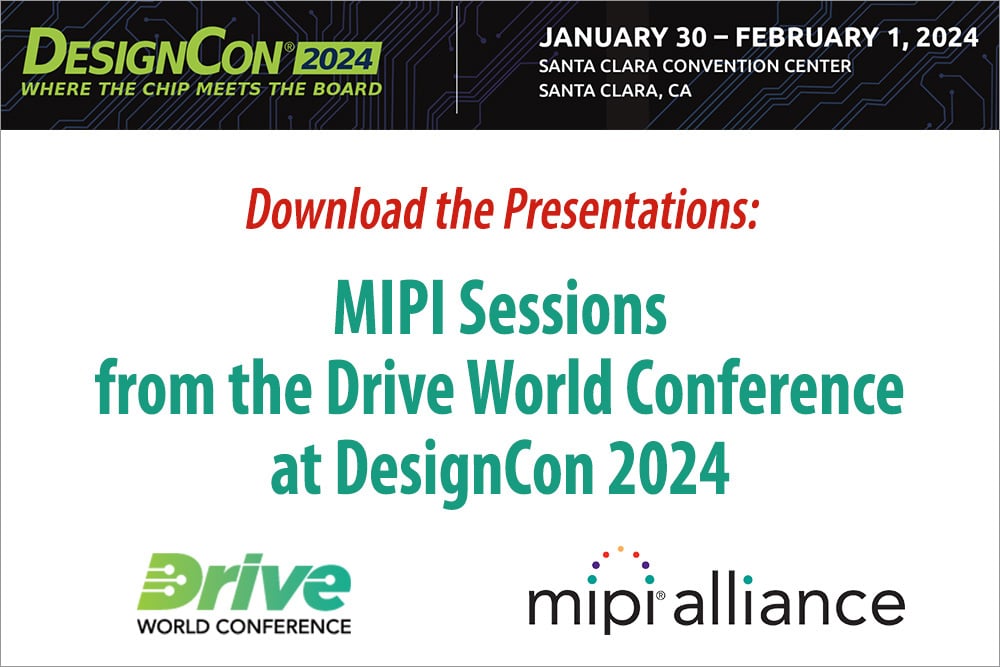3 min read
MIPI Presentations from the Drive World Conference at DesignCon 2024
![]() MIPI Alliance
:
30 December, 2023
MIPI Alliance
:
30 December, 2023

- Resources
- Conference Presentations
MIPI Tutorial and Member Presentations
Drive World Conference at DesignCon 2024
30 January - 1 February 2024
MIPI Tutorial: Enabling Trusted Automotive Machine Vision Applications Using MIPI Interfaces & Protocols
MIPI presented a three-part, in-depth tutorial, "Enabling Trusted Automotive Machine Vision Applications Using MIPI Interfaces & Protocols," at DesignCon 2024 as part of the Drive World Conference track.
Led by the developers of MIPI camera, A-PHY® and Security specifications, the tutorial provided a comprehensive overview of MIPI's latest automotive initiatives, focusing on how the use of MIPI CSI-2®, together with MIPI’s framework of approved PHYs and functional safety/security enablers, combine to help developers meet their automotive machine vision goals.
Part 1: Introduction to MIPI CSI-2 Features and Capabilities for Automotive Imaging Systems
This segment introduces the CSI-2 protocol, including an overview of the features that benefit automotive imaging systems, explores CSI-2 provisions to alleviate RF emissions, and highlights available physical layer options, including bridged and natively integrated options.
Presented by Haran Thanigasalam, Camera and Imaging Consultant for MIPI Alliance
Part 2: What’s New with the MIPI A-PHY v2.0 Automotive SerDes Interface
This segment covers the latest developments with MIPI A-PHY®, enhancements in the upcoming A-PHY v2.0, A-PHY’s use in software-defined vehicles, new Power Over A-PHY℠ power classes, the reference compliance test suite and creation of an A-PHY compliance program.
Presented by Edo Cohen, Co-Chair of the MIPI A-PHY Working Group
Part 3: Introducing MIPI’s CSI-2 Camera Cybersecurity Specifications for Automotive ADAS and ADS
This segment describes the approach MIPI has undertaken to secure connections "end-to-end" between CSI-2 image sensors and their related ECUs, and explains how MIPI’s application-based security approach is distinct from other methods in its extent and configurability.
Presented by Rick Wietfeldt, Co-Chair of the MIPI Security Working Group
MIPI-Related Member Presentations at the Event
DesignCon 2024 also included several presentations by MIPI members, including presentations on the value that test and measurement methodologies bring to automotive standards.
These sessions included:
Approaching Perfect Receiver Tolerance Tests: Using an AWG to De-Embed the Test Fixture While Embedding Channel Response
Stressed-Receiver Tolerance testing (Rx testing) requires a reference transmitter that generates a test signal with specifically calibrated impairments combined with a test interconnect with a specified worst-case differential insertion loss frequency response. A test fixture is necessary for connecting the reference transmitter to the receiver being tested, the DUT (device under test). The test fixture may include cables, connectors, adapters, splitters, etc, whose response is necessarily included in the stressed-signal calibration. Calibration of the stressed signal is the most time-consuming and difficult step in Rx testing. This paper introduces an approach that has been effective in Rx testing for the HDMI and MIPI standards: Use of an AWG (arbitrary waveform generator) to embed the required test channel response and specified signal impairments – like jitter and noise – directly into the test signal. The technique simplifies the tests and makes them more repeatable: calibration time is reduced, and physical compliance/variable-ISI boards are eliminated along with most of the test fixture cables and connectors. We show how to embed channel characteristics in impaired waveforms along with common pitfalls, and then turn to a communication channel model for automotive standards that typically have long channels and disparate cables.
Presented by BitifEye Digital Test Solutions GmBH
Automotive High-Speed Serial: How the Harsh Environment Challenges Established Technology & Test Methods
The harsh automotive environment includes sudden and prolonged attacks of electromagnetic interference (EMI), dynamic channel response variations caused by thermal and humidity fluctuations – temperature ranges of -40 to +150 C, and humidity variations from frozen to soaked to desiccated – and interconnects composed of multiple cable segments combined with reflection-generating inline connectors that, over years of use, suffer shielding degradation and channel attenuation. The expected lifetime of every component, without loss of signal integrity, is 20+ years and 200,000+ miles. Plus, conventional HSS (High-Speed Serial) equalization and Forward Error Correction (FEC) methods are inadequate for the varying magnitudes and spectra of automotive non-Gaussian, high peak probability, narrowband interference and crosstalk. Managing the signal-to-noise ratio and error rate in this unstable, safety-critical environment demands highly adaptive SerDes that dynamically track channel variations and are capable of some interference cancellation. Our presentation addresses the design, diagnostic, and compliance testing methodologies required to ensure durable, error-free automotive communication links composed of interoperable components through the vehicle lifespan. We'll conclude with a discussion of the requirements of the current HSS automotive standards – MIPI A-PHY, Automotive Ethernet, and ASA – and solicit audience comments on their strengths and weaknesses.
Presented by Valens Semiconductor & BitifEye Digital Test Solutions GmBH









